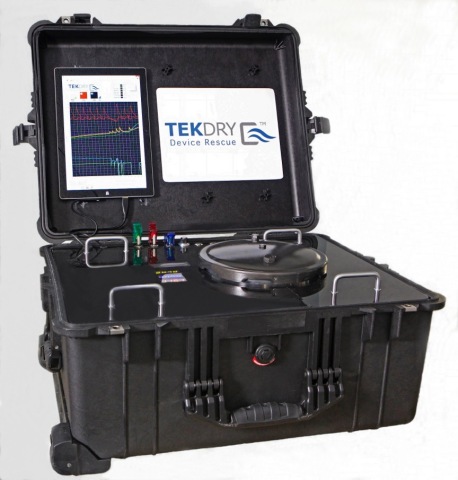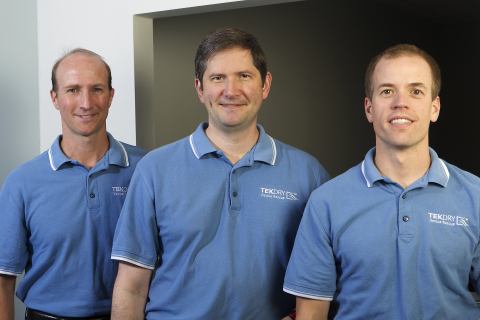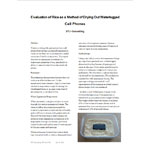DENVER--(BUSINESS WIRE)--A new scientific study released today by TekDry (www.tekdry.com), an emergency electronic device rescue service, shatters the widespread myth that placing a wet smartphone in a container of rice is an effective way to dry it.
The study, “Evaluation of Rice as a Method of Drying Out Waterlogged Cell Phones,” was conducted by DTJ Consulting and was commissioned by TekDry to explore the commonly held belief that placing a wet smartphone in a sealed container of rice for 48 hours effectively removes water from the phone.
“The optimal window of opportunity to restore a wet electronic device is less than 48 hours and it’s always best to act as soon as possible,” said Adam Cookson, TekDry’s co-founder. “The study clearly demonstrates that consumers should think twice before wasting crucial time with rice.”
The study not only proves that rice is not an effective drying agent, but that it is actually less effective than simply leaving the device out in the open to dry naturally on its own – but neither method will thoroughly dry the device.
“After monitoring the weight loss of a phone simulator placed first in an open room for 48 hours and second in a container of rice for 48 hours, both times containing the same initial weight of water at the same temperature, evaporation reduced the water weight of the device left in an open room by 14.7 percent while enclosing the device in a container of rice reduced the water weight of the device by 13.1 percent,” said David James of DTJ Consulting. “The results also clearly demonstrate that both evaporation in a room and a closed container of rice did very little to dry the device in 48 hours.”
DTJ Consulting created a smartphone simulator for this experiment because a waterlogged smartphone drips through openings and seams in its case, which makes it impossible to isolate and measure the weight loss only due to evaporation in a room or placement in a closed container of rice. The simulator is a plastic box with openings in the top totaling 42mm2, representative of the openings in current phone designs. The simulator contained a small folded piece of wet paper towel with a water weight equal to 10 percent of the volume of a selected smartphone, because the internal spaces of a smartphone occupy approximately 10 percent of its total volume.
“More than 22 million Americans lose their mobile devices to toilets, swimming pools, washing machines, drink spills, and other aquatic accidents each year and many believe the commonly held misconception – perpetuated on the Internet and in the media – that using rice to absorb water from a wet mobile device will dry and restore your mobile device to working order,” said Eric Jones, co-founder of TekDry. “This study lays the rice myth to rest.”
A detailed description of the rice experiment design, methodology, and results, a video demonstration of TekDry’s technology, and an infographic illustrating the study and including device rescue tips and statistics regarding wet mobile devices, are available on TekDry’s website.
TekDry’s patented device-rescue service completely restores within 30 minutes wet mobile devices including smartphones, laptops, tablets, and cameras, saving consumers time, money and the hassle of dealing with high insurance deductibles and costly device replacement fees.
TekDry recommends the following list of tips to save a wet phone:
1. DO NOT plug in your phone – Electricity and water just don’t mix.
2.
DO power off the phone – This will help prevent a short circuit.
3.
DO remove the battery if possible –Separating the battery from the phone
helps to keep electricity away from the waterlogged components. This
minimizes the chances of irreversible damage.
4. IF it was dropped
in salt water, DO rinse it in fresh water – Salt water will almost
certainly corrode and short the phone and will do more damage than fresh
water, so it is best to remove any traces of salt water quickly.
5.
DO dry with paper towel or washcloth – Removing any visible water from
the phone will keep it from seeping into the phone and doing more damage.
6.
DO NOT use rice – This method is ineffective as demonstrated in the
study announced today.
7. DO NOT use a blow dryer or oven – The
heat from these methods often warp and damage the sensitive equipment
inside your phone.
8. DO NOT use a microwave – A major component of
electronic devices is metal and metal in a microwave is a recipe for
disaster.
9. DO call TekDry – TekDry’s technology is most effective
when implemented as soon as possible within the first 48 hours. If your
phone can’t be restored, you pay only a small portion of the shipping
cost.
About TekDry
Headquartered in Denver, TekDry (www.TekDry.com) offers a nationwide emergency electronic device rescue service that quickly and safely dries wet electronic devices such as smartphones, laptops, tablets and digital cameras; restoring full device operability, saving valuable data such as photos and contacts and preventing further irreversible damage.
About DTJ Consulting
David James has broad knowledge of the electronics and computing industries through four decades of unprecedented technology advances. He has extensive experience in leading engineering projects covering system design, data storage, silicon chip architectures, manufacturing processes and computerized test systems. He has held senior positions with responsibility for technical strategy and future technology leadership for key products at IBM Corp, Xyratex, Fujitsu Ltd and Hitachi Global Storage.
DTJ Consulting offers practical engineering and technical marketing expertise across multiple technology segments. David’s knowledge of system design, electronics and physics is well suited to diverse projects and recent work has included SSD architecture, data recovery techniques, servo systems and embedded processor systems.







